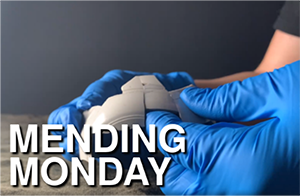Jef Pat at Home, Mending Monday
Main_Content
Short videos of how various artifacts fit back together.

|
| Fragments of a Blue Willow Platter These two fragments are part of the Blue Willow pattern, which was developed in 1790. Similar to original Chinese porcelain designs,
this pattern is one of the most popular and is still made today! |

| Animal bones are commonly found on most archaeological
sites. Depending on the site, bones can represent evidence of a peoples diet or their toolmaking. Turtles were not
only a reliable food source. Once cleaned, their shells could be repurposed as tools such as bowls or containers.
Turtle bones such as this almost complete turtle shell from the MAC Lab's collections are often found in both
prehistoric and colonial contexts. |

| Today’s feature is a lip and neck fragments of a stoneware
hollow vessel, most likely a jug, from the Horn Point site. This late 17th- and early 18th-century house site in
Dorchester County features many utilitarian vessels like this one. It was commonly used in food and drink preparation,
serving, and storage. Some earlier stoneware jugs were globular forms and later developed into more straight-sided body
forms around the 1860s. |

| Fine tooth combs such as this faunal one from Smith-Saint
Leonard, have been used for centuries as a method not only of style but of hygiene. Used to pick the lice eggs, or
nits, out of one’s hair fine-toothed combs are found at a great variety of sites. Made from a variety of materials
including faunal, wood, copper alloys, and more modernly from vulcanized rubber, this object continues to be a
common artifact type we still use today. |

| This partial salt-glazed stoneware teacup from the
18th century Smith-Saints Leonard site demonstrates the hard, dense, impermeable body characteristic of stoneware.
This partially mended artifact is an example of British stoneware with its very finished appearance. |

| This prehistoric ceramic is from the Rosenstock Site,
a Late Woodland village site located on a high bluff overlooking the Monocacy River. Without uncovering an expected
palisade feature with the first recording starting in 1970, some keyhole features were uncovered. These features
could be the remains of several culturally significant areas such as sweat-lodges, burials, and household features. |